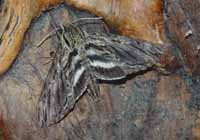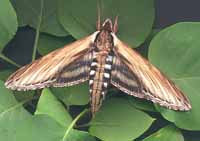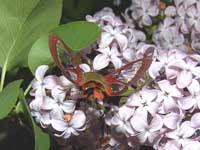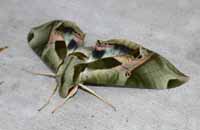Sphinginae subfamily
Sphingini tribe:
 |
Ceratomia amyntor
WO,
Elm Sphinx/Four-horned Sphinx:
Forewing upperside brown with dark brown & white markings including white costal area near wing base,
dark streaks along veins, & white spot in cell. Lower wing light brown & has dark brown band along outer margin.
Larvae feed on Elm (Ulmus), birch (Betula), basswood (Tilia), cherry (Prunus). |
 |
Ceratomia undulosa
WO, Waved Sphinx.
Forewing upperside pale brownish gray with wavy black & white lines & a black-outlined white cell spot.
Lower wing upperside gray with diffuse darker bands. |
 |
Lapara bombycoides
WO,
Northern Pine Sphinx.
The upperside of the forewing is gray with heavy black bands. The upperside of the hindwing is brownish gray with no markings.
The underside is rather plain.
|
 |
Lintneria eremitus,
WO, Hermit Sphinx: Fw upperside gray-brown with wavy lines, black dashes, & one or two small white spots near
center of costa. Hw upperside black with two white bands & triangular black patch at base. Note golden hair on thorax.
Larvae: beebalm (Monarda), mints (Mentha), bugleweed (Lycopis),
sage (Salvia).
|
 |
Manduca quinquemaculatus
WO, Five-spotted Hawkmoth.
This large bodied moth flies in tobacco fields and vegetable gardens
(potatoes, tomatoes) and wherever host plants are found.
|

|
Sphinx canadensis
WO,
Canadian Sphinx uncommon, often unreported.
Absence of white spot on forewing and more brownish coloration serve to separate canadensis from S. poecilus.
Hw fringe tends to be white on poecilus; checkered brownish on canadensis.
Larvae: white ash (Fraxinus americana), blueberry (Vaccinium). |
 |
Sphinx chersis
WO, Northern Ash Sphinx/Great Ash Sphinx
Forewing soft dark gray to blue-gray
with a series of black dashes, one of which reaches wing tip.
|
 |
Sphinx drupiferarum
WO,
Wild Cherry Sphinx.
Forewing costal area in basal and median regions: light grey. This colour also
appears in terminal area. Rest of wing dark slatey grey.
|
 |
Sphinx gordius
WO,
Apple Sphinx:
Colouration & markings highly variable from one specimen to another. Fw fringes mostly black with some white; those on hindwing mostly white
with few black patches.
Fw upperside ranges from brown with black borders through brownish gray with paler borders to pale gray with no borders.
Dashes, submarginal line, & cell spot are usually weak.
|
 |
Sphinx kalmiae
WO, Laurel Sphinx.
Lower forewings predominantly brownish-yellow with fairly wide dark bar along inner margin. At rest
wings hug body, giving moth a long slender look.
|
 |
Sphinx luscitiosa
MR,
Canadian Sphinx/Clemen's Sphinx.
Forewing yellowish gray in males & pale gray with faint yellow tint in females. In both sexes,
dark border on outer margin widens as it approaches inner margin.
Hindwing deep yellow in males, pale yellow in females; both with wide black border.
|
Sphinx luscitiosa male, Tie Mill Road, June 24, 2012, Mike Reese.
 |
Sphinx poecila,
WO,
Poecila Sphinx.
If you have blueberries in the woods, then you probably have the
Poecila Sphinx. Probably widespread throughout Wisconsin,
but are very much under reported.
|
 |
Sphinx vashti
WO, Snowberry Sphinx.
Forewing:narrow black subterminal line bordered by white inverted V-shaped line on outside, &
black line running inwards from wing apex.
Most often found in montane woodlands and along streamcourses.
|
Smerinthini Tribe:
 |
Amorpha juglandis
WO,
the Walnut Sphinx: The adults are also highly variable; sometimes wings of an individual may be all one color or may have several colors,
ranging from pale to dark brown, and may have a white or pink tinge. Patterns range from faint to pronounced.
|
 |
Pachysphinx modesta
AC,
Modest Sphinx/Poplar Sphinx.
This large poplar/willow feeder is likely present.
They are a heavy bodied species.
|
 |
Paonias excaecata
AC,
Blinded Sphinx,
Forewing outer margin quite wavy. Dark cell
spot & dark oblique line mid wing from costa almost to
inner margin. Basic ground colour pinkish brown. Flight: June-July.
|
 |
Paonias myops
WO,
Small-eyed Sphinx.
Both sexes rest with wings parallel to resting surface, with upper lobes of hindwings protruding above forewings. Ranges
across North America.
The hindwings have small blue eyespot ringed with black on yellow background.
|
 |
Smerinthus cerisyi
WO,
Cerisyi's Sphinx/One-eyed Sphinx, Larvae feed on poplars and willows.
Flight would be from late May-July as a single brood.
|
 |
Smerinthus jamaicensis
WO,
Twin-spotted Sphinx:
Closely resembles cerisyi, but jamaicensis smaller with larger blue patches on more vibrant/deeper
purple in hws. Note complete (outer margin to outer margin) off-white arc just below fw apex. In
cerisyi, lower portion of arc does not return to outer margin.
|
Macroglossinae subfamily
Dilophonotini Tribe:
See Hemaris comparison to help distinguish
the next three species.
 |
Hemaris aethra
Note large orangey-brown forewing apical patch. In very similar H. diffinis patch is smaller.
On average H. aethra, compared to H. diffinis, tends to be slightly larger, with more orangey-yellow tone,
less tapering (top to bottom) of dark thorax/abdominal region; more red nr hw anal angle. possibly limited to northern Wisconsin.
|
 |
Hemaris diffinis
WO,
the Snowberry Clearwing or Bumblebee Moth,
The moth flies along forest edges and in meadows, gardens and
brushy fields. Day-flying adults nectar at lantana, dwarf bush honeysuckle,
snowberry, orange hawkweed, thistles, lilac, Canada violet, etc.
|
 |
Hemaris gracilis
WO,
Slender Clearwing/ Graceful Clearwing.
Diurnal, most often seen nectaring during the day at flowers. Note smooth inner edge of burgundy forewing outer margin and
reddish upper surface of the legs.
|
 |
Hemaris thysbe
WO,
Hummingbird Clearwing. Not difficult to see why many gardeners would mistake an this moth for a small hummingbird as it hovers, sipping nectar from flowers
through a long feeding tube.
|
Philampelini Tribe:
 |
Eumorpha achemon
WO,
Achemon Sphinx.
Note the differences between this moth and the Pandorus Sphinx.
unlikely, further south in Wisconsin
|
 |
Eumorpha pandorus
WO,
Pandorus Sphinx.
If you have Grape/Virginia Creeper nearby, then you probably have
them. I often get asked to identify larvae from areas where
they have not previously been reported.
unlikely, further south in Wisconsin
|
Macroglossini Tribe:
 |
Amphion floridensis
WO,
Nessus Sphinix.
Widely distributed day flier. If you have Virginia Creeper,
you probably have Nessus Sphinx. Two bright, distinct, narrow
yellow bands are often visible on the abdomen.
|
 |
Darapsa choerilus,
WO,
Azalea Sphinx. You will often see this species listed as Darapsa pholus,
especially in older literature.
|
 |
Darapsa myron
WO,
Virginia Creeper Sphinx/
Grapevine Sphinx:
Fw dark brown to pale yellowish gray, with an olive tint, often more green than described.
Costal margin has dark rectangular patch, although this may be reduced or absent.
Hw pale orange.
|
 |
Hyles euphorbiae
WO, Spurge Hawk Moth.
Body light brown with various white & dark brown
markings, while wings have aconspicuous tan, brown, & pink or
red color pattern.
If this introduced species has not yet established a presence, I expect it will shortly.
|
 |
Hyles gallii
WO,
Bedstraw Hawk Moth/ Gallium Sphinx.
Dark brown with slightly irregular cream-coloured transverse line. Outer margin grey. Bright pink band on the hindwing.
Larvae are fond of Epilobium.
|
 |
Hyles lineata
WO,
White-lined Sphinx.
Adults usually fly at dusk, during the night, and at dawn, but they
also fly during the day over wide variety of open habitats
including deserts, suburbs, gardens.
|
 |
Sphecodina abbottii
WO,
Abbott's Sphinx: Adults are said to mimic bumblebees and make a buzzing sound when feeding. The wing margins are scalloped. The upperside of the
forewing is dark brown with light brown bands and markings. The upperside of the hindwing is yellow with a wide black outer margin.
|
|
|


